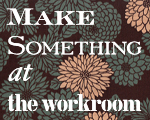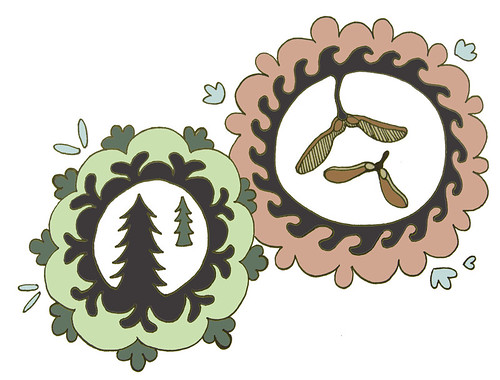ECOCRAFT: Sustainable Ceramics (?) by Krystal Speck
I came across this thought provoking and very relevant (to all makers, not just clay slingers) post on Krystal's blog and thought it was worth reposting here. If you want to weigh in on the discussion, please head over to the original post and leave your comments there.
Via sweetie pie press.
Most people think that the job of a potter or ceramist is a relatively green profession (we're talking environmentally green, not monetarily!). It's easy to understand why we might assume so, as many ceramic buyers, teachers and students I've spoken to like to believe that by using "earthy" materials, ceramics are also inherently earth friendly. However, anyone with their own ceramic practice who has felt that pang of guilt from washing glaze down the sink or firing a not-so-nice pot into permanence knows that just isn't the case.
I've had conversations with friends in the business, questioned my practices and theirs, seeming to only end up with more questions. As I searched the internet for "greener" ceramics, I was surprised to find very little online discussion on this topic from any respected ceramic magazines or suppliers. Where the discussion seems to be growing most is on (wait for it!) blogs. Some of my favourite ceramic artists have weighed-in on the issue, honestly examining the environmental impact that their ceramic businesses incur.
On Diana Fayt's blog, One Black Bird, guest-blogger Laura Zindel describes her own frustrations with ceramic producers who describe their work as completely sustainable. She writes:
"On one site, a potter making very nice copper reduction pots states on his web site ... 'No toxic materials are used in these ceramics, they are therefore maker, user, and environmentally friendly . The work is 'Reduction' fired in a 40 cu. ft. Natural Gas kiln to a temperature of approx. 1340 degrees centigrade (cone14). The firing takes about 24 hours to reach top temperature.'"
"Just about everything in this statement makes me so mad I don't even know where to start. First we have silica, then copper, then reduction, 40ft cu kiln, and end with Natural Gas I think, are you tripping. This is the kind of stuff that is really going to confuse someone that does not know about ceramics. It confused me, and I know a thing or two."
Many potters and ceramic artists may never have considered their industry to be a contributor to the pollution of our water and soil, industrial mining or global warming. If they do ponder this fact, it isn't always so easy for independent ceramic businesses to over-haul their production processes and re-design their wares (and aesthetic choices?) to be less harmful. This could mean switching clay bodies, changing firing temperature, buying or trading for a new/different kiln, using a limited range of glazes and producing batches upon order with no excess inventory. At the most extreme, it could mean choosing not to make art in any non-biodegradable or toxic form (I'm interested to hear what these might be). These are all possible changes, but I think most people refrain from doing these things because of mental blocks, not to mention financial costs.
In her blog entry on the subject, Emily Murphy writes:
"I think my aversion to actually writing this post [on green ceramics] that has been in my head is the same thing that stops many of us from creating greener lives. I wanted this post to be epic, to have all of the answers. It was going to be very complete and very satisfying. But that is truly an impossible task. When I think about all of the environmental changes that I want to make at home or at my studio, the ultimate goal is overwhelming and paralyzing. The only way to get past the paralysis is to stop for a moment, and break it down into steps. The steps will get you closer to your end goal, but they are much easier to conquer than taking a gigantic leap."
If you would like to learn practical ways of making your ceramic studio more sustainable, I highly recommend reading more of Emily Murphy's blog post, "A path to being a greener potter," which is linked below. She lists some very practical ways art studios can reduce their ecological footprint.
Of course, if you have the space and the dough, there are solar powered electric kilns! And I've heard discussions online about artists outfitting their studios with solar panels that power their kilns (this power can also be recycled to heat your studio/home). Check out Steve Harrison's solar studio set-up and his suggestions to help reduce your eco-footprint: http://www.hotnsticky.com.au/sustain.htm.
Links for you:
SHUT UP AND COLOUR: http://www.facebook.com/ext/share.php?sid=48812473697&h=f_AiE&u=t9_TD
EMILY MURPHY: http://potteryblog.com/2007/10/a-path-to-being-a-greener-potter/
DIANA FAYT: http://oneblackbird.blogspot.com/2007/07/green-ware-question.html
STEVE HARRISON: http://www.hotnsticky.com.au/sustain.htm
DAVISTUDIO: http://davistudio.blogspot.com/2007/08/my-list.html
Via sweetie pie press.
Most people think that the job of a potter or ceramist is a relatively green profession (we're talking environmentally green, not monetarily!). It's easy to understand why we might assume so, as many ceramic buyers, teachers and students I've spoken to like to believe that by using "earthy" materials, ceramics are also inherently earth friendly. However, anyone with their own ceramic practice who has felt that pang of guilt from washing glaze down the sink or firing a not-so-nice pot into permanence knows that just isn't the case.
I've had conversations with friends in the business, questioned my practices and theirs, seeming to only end up with more questions. As I searched the internet for "greener" ceramics, I was surprised to find very little online discussion on this topic from any respected ceramic magazines or suppliers. Where the discussion seems to be growing most is on (wait for it!) blogs. Some of my favourite ceramic artists have weighed-in on the issue, honestly examining the environmental impact that their ceramic businesses incur.
On Diana Fayt's blog, One Black Bird, guest-blogger Laura Zindel describes her own frustrations with ceramic producers who describe their work as completely sustainable. She writes:
"On one site, a potter making very nice copper reduction pots states on his web site ... 'No toxic materials are used in these ceramics, they are therefore maker, user, and environmentally friendly . The work is 'Reduction' fired in a 40 cu. ft. Natural Gas kiln to a temperature of approx. 1340 degrees centigrade (cone14). The firing takes about 24 hours to reach top temperature.'"
"Just about everything in this statement makes me so mad I don't even know where to start. First we have silica, then copper, then reduction, 40ft cu kiln, and end with Natural Gas I think, are you tripping. This is the kind of stuff that is really going to confuse someone that does not know about ceramics. It confused me, and I know a thing or two."
Many potters and ceramic artists may never have considered their industry to be a contributor to the pollution of our water and soil, industrial mining or global warming. If they do ponder this fact, it isn't always so easy for independent ceramic businesses to over-haul their production processes and re-design their wares (and aesthetic choices?) to be less harmful. This could mean switching clay bodies, changing firing temperature, buying or trading for a new/different kiln, using a limited range of glazes and producing batches upon order with no excess inventory. At the most extreme, it could mean choosing not to make art in any non-biodegradable or toxic form (I'm interested to hear what these might be). These are all possible changes, but I think most people refrain from doing these things because of mental blocks, not to mention financial costs.
In her blog entry on the subject, Emily Murphy writes:
"I think my aversion to actually writing this post [on green ceramics] that has been in my head is the same thing that stops many of us from creating greener lives. I wanted this post to be epic, to have all of the answers. It was going to be very complete and very satisfying. But that is truly an impossible task. When I think about all of the environmental changes that I want to make at home or at my studio, the ultimate goal is overwhelming and paralyzing. The only way to get past the paralysis is to stop for a moment, and break it down into steps. The steps will get you closer to your end goal, but they are much easier to conquer than taking a gigantic leap."
If you would like to learn practical ways of making your ceramic studio more sustainable, I highly recommend reading more of Emily Murphy's blog post, "A path to being a greener potter," which is linked below. She lists some very practical ways art studios can reduce their ecological footprint.
Of course, if you have the space and the dough, there are solar powered electric kilns! And I've heard discussions online about artists outfitting their studios with solar panels that power their kilns (this power can also be recycled to heat your studio/home). Check out Steve Harrison's solar studio set-up and his suggestions to help reduce your eco-footprint: http://www.hotnsticky.com.au/sustain.htm.
Links for you:
SHUT UP AND COLOUR: http://www.facebook.com/ext/share.php?sid=48812473697&h=f_AiE&u=t9_TD
EMILY MURPHY: http://potteryblog.com/2007/10/a-path-to-being-a-greener-potter/
DIANA FAYT: http://oneblackbird.blogspot.com/2007/07/green-ware-question.html
STEVE HARRISON: http://www.hotnsticky.com.au/sustain.htm
DAVISTUDIO: http://davistudio.blogspot.com/2007/08/my-list.html























0 Comments:
Post a Comment
<< Home